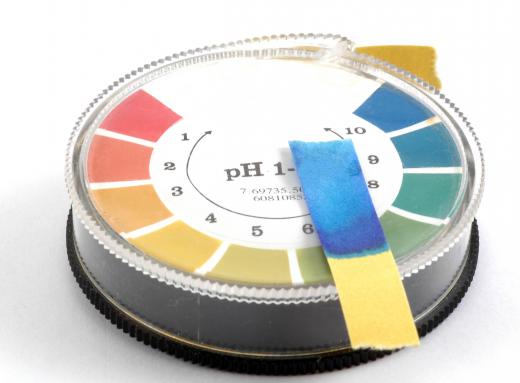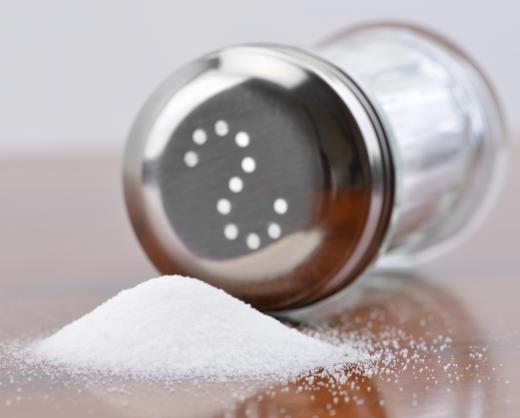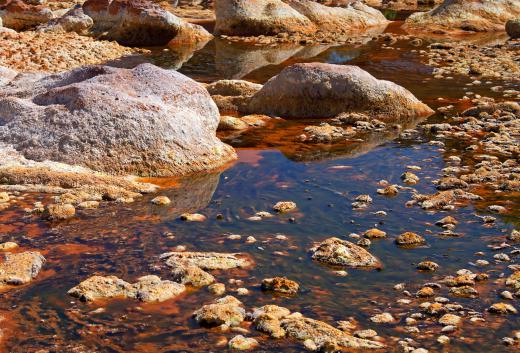What are Acid-Base Reactions?
Acid-base reactions are chemical reactions that occur between acids and bases. An acid is a substance that, when dissolved in water, has greater hydrogen ion activity than pure water does, while a base is a substance that, when dissolved in water, can accept hydrogen ions. The acidity of a solution is measured based on the pH scale; a substance with a pH less than seven is acidic while a solution with a pH greater than seven is basic. There are many different explanations and forms of acid-base reactions, as they can occur in many different ways and have been studied by a number of different chemists.
There are several different properties that define acids and bases other than whether they can give or receive hydrogen ions. Acids change blue litmus paper to red, have a sour taste, and react with some metals to liberate oxygen. Bases, on the other hand, change red litmus paper to blue, have a bitter taste, and often have a slippery feeling. Both acids and bases conduct electricity.

Typically, when an acid and a base are reacted together, they yield a salt. Salts are the neutral products of acid-base reactions. For example, when hydrochloric acid is reacted with sodium hydroxide, a strong base, the product of the reaction is NaCl, or sodium chloride, which is common table salt and is neither acidic or basic, having a pH of about seven. When salts are dissolved in water, they are known as electrolytes and they conduct electricity. There are several different classifications of salts, as some release hydroxide ions when dissolved, some release hydronium ions, and some release neither.

There are many different kinds of acid-base reactions because there are many different kinds of acids and bases that can all be reacted in different quantities. A strong acid reacted with a weak base will have a different result than a weak acid reacted with a weak base, because strong acids release more hydronium ions into a solution than weak acids and strong bases release more hydroxide ions into a solution than weak bases.

Acid-base reactions are studied at all levels of chemistry, beginning in high school, as they are integral to many careers that involve chemistry. The human body has many different ongoing acid-base reactions that are kept in a delicate equilibrium to moderate various bodily functions. Pharmaceutical companies, then, need to ensure that the drugs they make do not upset such delicate balances.
AS FEATURED ON:
AS FEATURED ON:













Discussion Comments
@bythewell - In fact, the sodium hydroxide and hydrochloric acid reaction is one of the common ones they used to teach us about the chemical notation when I was doing chemistry at school.
If I remember correctly it was NaOH + HCl becomes NaCl + H2O, because the two products of the reaction are salt and water.
It is a bit strange that two such dangerous (although still useful) substances will become two substances that are both extremely necessary for life. But, I think it's often the case with chemistry that volatile substances will react with each other in order to become more stable. It's all about the exchanges of electrons and things.
And a good thing too, or we'd have a much more dangerous world to live in.
I actually didn't realize that salt was a neutral pH and that it could conduct electricity. There is so much salt in the world, in the ocean particularly, it's strange to think that it's actually the result of an acid-base reaction and consists of two separate elements.
And the acid and base that make it up are actually quite dangerous.
I know hydrochloric acid is one of the components of our stomach acids, so it must be strong enough to dissolve things.
And sodium hydroxide is lye, which is what they use to make soap. And it is definitely strong enough to burn your skin, which is why soap makers always use gloves.
Post your comments